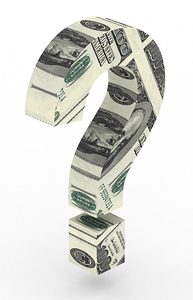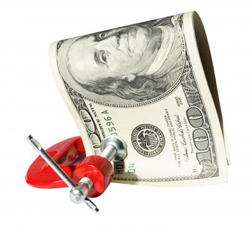What to Look For in an Exhibit Design and Cost Proposal
Make sure your trade show costs fit into your budget.
One of the biggest challenges that exhibit marketers face is that their bosses give them a solid budget to do a show, but the vendors that they need to make it all happen refuse to lock into a quotation. This problem exists in just about every area of tradeshow expense.
 Most display companies will provide quotes for design and construction but do only “budgetary estimates” for field services. This leaves the door wide open to budget-blowing additional charges after the show. When clients ask for firm quotes for drayage, I&D, or electrical, their Account Executives deliver a well-rehearsed speech that they “cannot quote services that they can’t control,” or some other excuse their bosses have taught them.
Most display companies will provide quotes for design and construction but do only “budgetary estimates” for field services. This leaves the door wide open to budget-blowing additional charges after the show. When clients ask for firm quotes for drayage, I&D, or electrical, their Account Executives deliver a well-rehearsed speech that they “cannot quote services that they can’t control,” or some other excuse their bosses have taught them.
Also, General Services Contractors provide forms and other tools to allow trade show exhibitors to estimate their own field services costs but then insist on a credit card on file so that actual charges can be tacked on after the show. How in the heck do you budget for this?
There are exhibit companies that provide “turn key quotations” – if you absolutely cannot exceed a certain budget for a show, I would recommend that you find one. You will always have problems budgeting for hotel accommodations, travel expenses, and other show related costs, but you’ll at least be able to get the cost of your display, shipping, setup and dismantle, and utilities locked in.
We are ready to earn your business! Let’s talk.
Do Tradeshow Logistical Costs Influence the Decision to Exhibit?
In difficult economic times, companies look closely at every expense.
 When money is tight, they must decide whether it is still wise to allocate resources to areas that may have been a “no-brainer” in stronger markets. Naturally, marketing expenses are no exception, and trade show exhibiting can be a large portion of many companies’ marketing budgets. The cost of logistics for tradeshow exhibiting (freight, drayage, setup, electrical, etc.) can be substantial. As a result, it will almost certainly be a candidate for the chopping block when executives start cutting back.
When money is tight, they must decide whether it is still wise to allocate resources to areas that may have been a “no-brainer” in stronger markets. Naturally, marketing expenses are no exception, and trade show exhibiting can be a large portion of many companies’ marketing budgets. The cost of logistics for tradeshow exhibiting (freight, drayage, setup, electrical, etc.) can be substantial. As a result, it will almost certainly be a candidate for the chopping block when executives start cutting back.
However, the decision to exhibit in a show is seldom based entirely on logistical costs. As long as advertised attendance figures are favorable, and the following items are true of a show, a company will find the funds to exhibit.
- The company has something to show it’s customers, both current and potential.
- Their competitors will be attending.
- Their biggest customers will be attending.
They may scale back their exhibit space, look at alternative ways to make a presence, or just complain about having to spend the money, but one way or another, they’ll be there. It’s a difficult reality, but in business, perception is important. When a company doesn’t attend a major show, the first thing attendees think is that they must be either in dire straits financially, or that they had nothing to show, and therefore are not worth considering as a vendor. Companies must carefully consider all the potential areas of impact before deciding not to attend a show.
Looking for areas to trim your tradeshow exhibiting budget? Let’s Talk.
Tradeshows on a Shoestring Budget
Attending and exhibiting at a tradeshow can lead to excellent bottom-line benefits for your company: exposure to a highly targeted audience; opportunity to pitch your company’s marketing message; generation of sales leads; and the opportunity to learn more about your industry through panel discussion, speeches, and seminars.
 The reality, though, is that in many companies, marketing budget dollars must be spent carefully and each expense may be scrutinized closely. No need to remove tradeshows completely from your marketing plan, however. Take a critical look at your tradeshow expenses and you might find some creative ways to carve some costs out of your overall tradeshow budget.
The reality, though, is that in many companies, marketing budget dollars must be spent carefully and each expense may be scrutinized closely. No need to remove tradeshows completely from your marketing plan, however. Take a critical look at your tradeshow expenses and you might find some creative ways to carve some costs out of your overall tradeshow budget.
Here are a few areas where you might be able to cut costs:
Transportation. This can typically account for a significant portion of your tradeshow budget so it’s the first place you should look at to trim down on expenses. The biggest thing to keep in mind: plan early! Most companies will know six months to a year out that they are going to be exhibiting at a particular show, so plan ahead and make your airline reservations early. Airlines penalize last-minute business travelers with high-priced tickets. Fly everyone in the day before the show and fly them out the last day of the show to save on extra food and lodging costs.
Also, keep in mind other modes of transportation if the event isn’t that far away. Renting a van to take a large group of people or partner with another exhibitor in your area and charter a bus, which can significantly cut down on travel expenses.
Hotel. Typically larger conferences will offer attendees and exhibitors rooms at hotels within a close proximity to the event at a discounted rate. Take advantage of this savings. Booking an economy hotel farther away might seem like a smart strategy, but once you add up taxi fares, it might not make sense. Double up employees in each room to instantly cut hotel costs in half.
Also, if you’re attending multiple events throughout the year, look at hotel chains that offer special discounts for multiple hotel stays or those that offer special member programs that offer additional discounts, such as free nights after a certain amount of stays. Also, book at hotels that offer free breakfast. It might sound silly, but feeding a large group of people breakfast every day will add up to hundreds of dollars after a multi-day stay, and possibly bloat your budget.
Booth rentals. You can instantly shave hundreds off your budget by renting your tradeshow booth. This can be especially helpful for companies that want to exhibit but need to cut tradeshow costs in the short-term as well as for those companies that don’t attend shows frequently. Make sure you read your rental agreement carefully and understand the terms of it. Find out what accessories will come with the booth and what you’re responsible for bringing. Be creative and enhance your rental booth with banner stands, literature racks, lighting and other extras that can increase traffic to your booth.
Shipping. Exhibition halls often add significant costs to receiving and storing your freight and associated material for your company. Instead, ship things such as literature and giveaways directly to your hotel. Mark shipped boxes with a shipping label that reads, “Hold at front desk for (your name)’s arrival.” Hotels do not charge for accepting and holding shipments for guests.
Trade Show Strategies: 5 Ways to Cut Cost and Make a Big Impression
It’s just smart business to look for ways to get more from your trade show budget.  Since your competitors are probably getting creative with their budget too, it’s the perfect time to take advantage of the situation with some out of the box thinking.
Since your competitors are probably getting creative with their budget too, it’s the perfect time to take advantage of the situation with some out of the box thinking.
There are lots of ways to save money on your trade show budget – from managing travel and entertainment expenses to strategies for consolidating shipments to the show – but I’ll leave all of that to you. My focus is on ways to save money on your trade show booth without giving up any marketing impact. Here are a few tips on how your trade show booth can be high-impact for less money.
- Reduce transportation costs with a new lower-weight booth
Trade show design has really changed in recent years. High energy and transportation costs pushed design houses to rethink their approaches. New booths are constructed from light-weight, high strength materials, are less expensive to ship and also have a sleeker, more contemporary look. - Design for easy assembly
As designers began to work with new materials and modular components, hard-to-assemble booths built with rigid infill panels and wooden construction have gone the way of the dinosaur. Find a design firm with a proven track record of creating booths that have big graphic impact but do not require a cast of thousands to set up. - Rent – don’t buy
Many large trade show design firms rent trade show components and booths. If your company only has one or two trade show events each year, or you need to get a larger booth just for one annual trade show, renting can be a great option. - Buy a Used Trade Show Booth and Accessories
Some companies trade in or sell off trade show displays frequently in order to update their display to match their latest ad campaign. A smart buyer can pick up a like-new display for a fraction of the original price. If you take this route, be sure to buy from a provider who refurbishes and customizes displays. - Update your current Trade Show Display
If your company already has trade show booths, take an objective look to see if they can be updated to fit your current needs for an affordable price. Be careful about investing in an outdated booth that is very costly to transport, assemble and operate because it can represent a false savings. However, sometimes the most cost-effective path is to update graphics, fabric and add new components to an existing booth.
If you’re ready to save money on your trade show budget, Let’s Talk.
Chasing Tradeshow Cost Savings?
Many exhibitors are being forced to find ways to reduce the cost of participation in tradeshows. The most common way this task is approached is to look at each cost line item and see what can be done to save money.

The common first step is to contract for a smaller booth space. This not only saves on the cost of the space rental but also provides an across-the-board cost reduction. The downside of such a reduction? You may have to settle for a less than desirable booth location and you’ll also need to make sure your display properties will fit in the smaller format.
After booth space, the likely second step is to look at each cost category for the show and try to determine which costs can be reduced. This is a very time-consuming process, and usually entails trying to find out how much your exhibit weighs and how long it should take to set up. This information is not always easy to get your hands on, and when you do, there are always a slew of variables that can affect the final cost of the show.
In my opinion, however, the best first step to take is to contact your exhibit supplier (assuming they store and manage your display) and lay your cards on the table. Explain to them that you have been asked to cut 25% off the cost of last year’s show. Ask them to provide recommendations. Remember, they do this for a living! They are not likely to be overly excited about this mission, but they should support you through good times and bad.
If they can’t or won’t provide you with some good ideas, you should probably consider finding another supplier.
Thinking about changing exhibit companies? Let’s Talk.
Trade Show Tips – How to Do More with Less
A reality of the past years of recession is that companies across all industries have had to tighten their belts when it comes to marketing initiatives. One of the biggest and most costly pieces of the marketing pie is trade show exhibition. Marketers and exhibit managers are then faced with a challenge.  How do they increase sales and bottom-line revenue without the resources to amp up their marketing efforts?
How do they increase sales and bottom-line revenue without the resources to amp up their marketing efforts?
Borne out of necessity and a lack of monetary influx into their existing budgets, many marketers and exhibit managers have found creative ways to do just that. And, it’s no magic trick. Simple cost cutting measures that help shift resources and reallocate money into areas of your company’s marketing efforts that can deliver the most benefits and payoff during economic downturns, such as trade shows.
Here are a few ways you can cut money out of your exhibit budget:
Buy, don’t rent. Renting accessories, equipment and individual components (display racks, folding chairs and tables, etc.) from an exhibit hall or show- appointed vendors adds significant expense to your overall exhibition budget. Save big bucks by shipping these items from your home office or storage warehouse. Even with shipping and drayage costs, you’ll still come out ahead for most items. This logic applies to your actual booth itself; if you exhibit at multiple shows per year, but don’t rent.
Cut travel expenses. Hotel costs for traveling staff members can very quickly add up and bloat your trade show budget. Learn to negotiate with hotels to get the best deals; also, bigger shows typically negotiate with local hotels to offer special “show” rates for exhibitors and attendees. Join hotel chains’ customer loyalty programs to get other free bonuses, such as free stays after a certain number of stays. Double up employees of the same sex in one room and look for hotels that offer free breakfast.
Lighten your load. Reduce your shipping and drayage costs by taking a close look at what you’ll really need on-site and in your booth. Focus on one product to highlight; don’t bring every product in your line. An overcrowded booth is a turnoff for attendees and makes it more difficult for visitors to focus on the one product you’re announcing or launching at the show. You might also be able to trim some off your drayage costs by shipping some things, such as brochures and other collateral material, directly to your hotel.
Order show services carefully. This is kind of like the hotel mini-bar. Seems so convenient, but when you check out and see that you shelled out $7.50 for that can of pretzels, you might think otherwise. Order the necessities (electricity, lighting, booth cleaning, etc.) by the earliest deadline and you might be eligible for a discount. Determine the actual wattage needs of your equipment and make sure that you don’t order more than you need and bring your own electrical power strips.
Want to see how we can help you take advantage of these cost-saving tips and more? We’ll do it right for you – Let’s Talk.
Archives
- July 2021
- June 2021
- May 2021
- April 2021
- October 2018
- September 2018
- August 2018
- July 2018
- June 2018
- May 2018
- April 2018
- March 2018
- February 2018
- January 2018
- December 2017
- November 2017
- October 2017
- September 2017
- August 2017
- July 2017
- June 2017
- May 2017
- April 2017
- March 2017
- February 2017
- January 2017
- December 2016
- November 2016
- October 2016
- September 2016
- August 2016
- July 2016
- June 2016
- May 2016
- April 2016
- March 2016
